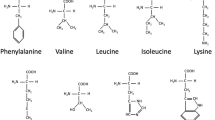Abstract
Six edible Thai mushroom species were analysed for protein, in vitro protein digestibility, amino acids and major and trace elements. The results for protein and amino acids were discussed relative to the contents in Thai rice. The contents of mineral elements showed great variation, in agreement with literature data. Two samples (Hunukao and Hom) were rich in calcium and one (Phang) was rich in iron and copper. For comparison results for samples of edible mushrooms obtained in Norway were included.
Similar content being viewed by others
References
Andersen A, Lykke S-E, Lange M, Bech K (1982) Trace Elements in Edible Mushrooms. DK-2860 Statens Levnedsmiddelinstitutt
Bano, Z., Srinivasan, K.S., Srivastava H.C. (1963) Amino acid composition of the protein from a mushroom (Pleurotus sp). Appl Microbiol 11:184–187
Bano, Z., Bhagya, S., Srinivasan, K.S. (1981) Essential amino acid composition and proximate analysis of the mushrooms Pleurotus eous and Pleurotus florida. Mushrooms Newsletter for the Tropics 1:6–10
Bano, Z., Nagaraja, K., Vibhakar, S., Kapur, O.P. (1981) Mineral and the heavy metal contents in the sporophores of Pleurotus species. Mushroom Newsletter for the Tropics 2:3–7
Buttery, P.J., Soar, J.B. (1975) A spectrofluorimetric assay of the tryptophan content of feedstuffs. J Sc Food Agric 26:1275–1277
Chavana, S., Haque, A., Njaa, L.R., Pettersen, J. (1980) Methods for methionine and cyst(e)ine determination. A comparison between two institutes. J Sci Food Agric 18:274–278
Crooke, W.M., Simpson, W.E. (1971) Determination of ammonium in Kjeldahl digests of crops by an automated procedure. J Sci Food Agric 22:9–10
FAO.WHO (1976) Food standards programme, List of maximum levels recommended for contaminants by the joint FAO/WHO Codex alimentarius Commissions FAO.WHO Rome
FAO/WHO/UNU (1985) Energy and protein requirements, Report of a Joint FAO/WHO/UNU Expert Consultation World Health Organisation Technical Report Series 724 WHO Geneva
Hayes, W.J. (1976) The food values of the cultivated mushroom and its importance to the mushroom industry. Mushroom J 40:104–110
Howe, E.E., Jansen, G.R., Gilfillan, E.W. (1965) Amino acid supplementation of cereal grains as related to the world food supply Am J Clin Nutr 16:315–320
Hsu, H.W., Vavak, D.L., Satterlee, L.D., Miller, G.A. (1977) A multi-enzyme technique for estimating protein digestibility. J Food Sci 44:1269–1273
Jandaik, C.L. (1976) Amino acid composition of mushroom. The Mushroom J 4:154–156
Julshamn, K., Haugsnes, J., Utne, F. (1978) The contents of 14 major and minor elements (minerals) in Norwegian fish species and fish byproducts, determined by atomic absorption spectrophotometry. Fisk Dir Skr, Ser Ernæring 1:117–135
Julshamn, K., Ringdal, O., Slinning, K-E., Brækkan, O.R. (1982) Optimization of the determination of selenium in marine samples by atomic absorption spectrophotometry: Comparison of a flameless graphite furnace atomic absorption system with a hydride generation atomic absorption system. Spectrochim Acta 37B:473–482
Julshamn, K., Andersen, K-J. (1983) Subcellular distribution of major and minor elements in unexposed molluses in Western Norway I The distribution and binding of cadmium, zinc and copper in the liver and the digestive system of the oyster (Ostrea edulis). Comp Biochem Physiol 75A:9–12
Kurtzman, R.H. (1975) Mushrooms as a source of food protein. In: Friedman, M. (ed) Protein Nutritional Quality of Foods and Feeds, Part 2 305–318 New York Marcel Decker
Miller, E.L. (1967) Determination of the tryptophan content of feedingstuffs with particular reference to cereals. J Sci Food Agric 18:381–386
Njaa, L.R. (1980) A method for determination of unoxidised and total methionine in protein concentrates, with special reference to fish meals. Br J Nutr 43:339–348
Sachse, J. (1981) Ein Beitrag zur Bestimmung von Tryptophan in Mais und Futterpflanzen. Z Lebensmitt Untersuch Forsh 172:272–277
Sayeed, S., Njaa, L.R. (1985) Effect of a Bangladeshi home-cooking procedure on the amino acid content, trypsin inhibitor activity and in vitro digestibility of some legume seeds. Qual Plant Plant Foods Hum Nutr. Qual Plant Plant Foods Nutr 35:379–388
Seelkopf, C., Schuster, H. (1957) Qualitative und quantitative Aminosaurebestimmungen an einigen wichtigen Speisepilzen. Z Lebensmitt Untersuch Forsh 106:177–187
Varo, P., Lahelma, O., Nurtamo, M., Saari, E., Koivistonen, P. (1980) Mineral element composition of Finnish foods VII Potato, vegetables, fruits, berries, nuts and mushroom. In: Koivistonen P (ed) Acta Agric Scand Suppl 22:106–113
Author information
Authors and Affiliations
Rights and permissions
About this article
Cite this article
Surinrut, P., Julshamn, K. & Rein Njaa, L. Protein, amino acids and some major and trace elements in Thai and Norwegian mushrooms. Plant Food Hum Nutr 37, 117–125 (1987). https://doi.org/10.1007/BF01092047
Received:
Accepted:
Issue Date:
DOI: https://doi.org/10.1007/BF01092047




